Article Highlights
Smithsonite is not just a mineral; it’s a marvel of nature with a rich history and a dazzling array of colors. Composed of zinc carbonate (ZnCO3), this gemstone was once a major player in the early days of metallurgy, serving as a critical ore of zinc. Beyond its industrial importance, smithsonite captivates collectors and enthusiasts with its translucent hues ranging from vibrant blues and greens to soft pinks and yellows.
The Palette of Nature

Imagine holding a piece of the earth’s artistry in your hands. Smithsonite offers just that, with colors that tell stories of geological processes and mineral mixtures. Its typical shades of brown, gray, white, green, and yellow are beautiful, but it’s the rare, bright colors that make collectors’ hearts skip a beat. Each piece is unique, reflecting the journey it has undergone deep within the earth.
A Stone of Many Uses
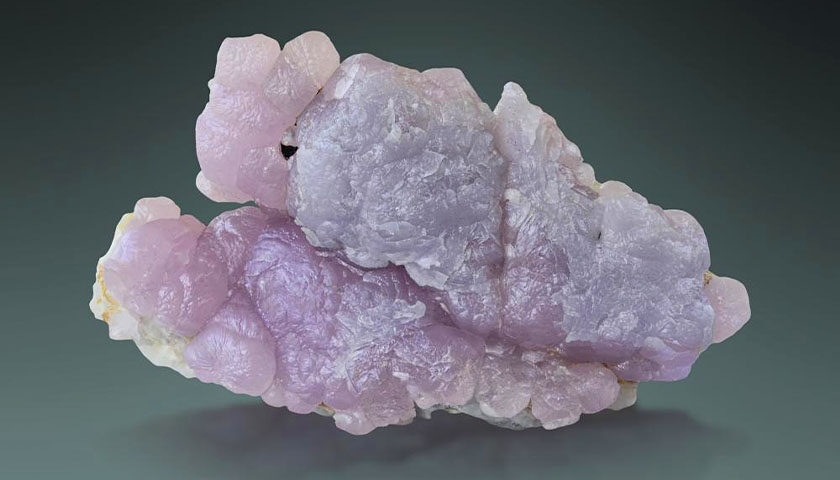
While smithsonite’s role has shifted from an industrial powerhouse to a collector’s gem, its allure remains unchanged. The stone is not only admired for its beauty but also cut into gems and used as an ornamental stone, adding a touch of nature’s elegance to various settings. Whether showcased in a museum or worn as a subtle piece of jewelry, smithsonite continues to fascinate with its natural charm and historical significance.
Smithsonite Crystals
Smithsonite is a mineral that loves to play hide and seek with its admirers. Rarely seen as well-formed crystals, this elusive gemstone typically presents itself as a druse of small, sparkling crystals over a piece of country rock. One such example is the captivating grayish-green crystals found in Namibia, which are a testament to smithsonite’s subtle yet undeniable beauty.
The Elusive Beauty
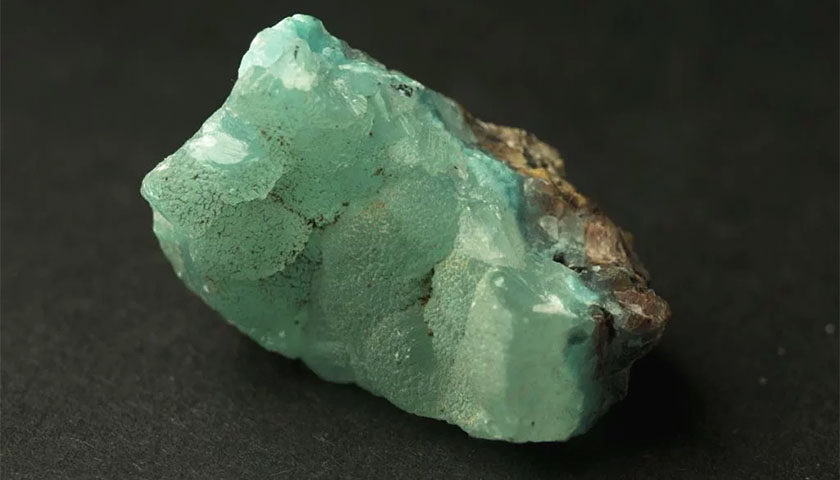
When you come across smithsonite crystals, you’re witnessing a rare spectacle. The scarcity of well-formed crystals adds to the stone’s mystique and value, making any specimen a prized possession. Its atypical crystal habit only heightens the intrigue, inviting onlookers to delve deeper into its origins and appreciate the unique conditions that brought it into existence.
A Canvas of Minerals

Each piece of smithsonite is a snapshot of the earth’s creativity. The druse of crystals adorning the country rock is not just a mineralogical feature; it’s a natural masterpiece. The way these crystals catch the light and display their color is a constant source of wonder, showcasing the endless variety and beauty of the natural world.
Dry-Bone Ore
Among the many faces of smithsonite is the intriguing variety known as dry-bone ore. This impure and friable form is recognized by its distinctive honeycomb-like structure, a testament to the dynamic and ever-changing conditions of the earth’s surface.
A Glimpse into the Past
Dry-bone ore tells a story of transformation and survival. Found in areas where zinc deposits have been exposed to the elements and oxidized, this variety of smithsonite is a direct link to the geological past. Its peculiar structure and composition provide valuable clues about the environmental conditions and processes that shaped our planet’s mineral wealth.
A Mineralogist’s Delight
For those with a passion for the earth’s treasures, dry-bone ore is a fascinating subject. Its unique appearance and formation process make it an object of study and admiration. Whether you’re a seasoned collector or a curious newcomer to the world of minerals, the allure of dry-bone ore’s otherworldly shapes and textures is undeniable.
Physical Properties of Smithsonite

Smithsonite is a treasure trove of physical characteristics that not only define its identity but also contribute to its allure and fascination. With a chemical classification as a carbonate, it’s the intricate details and vibrant colors that make smithsonite a standout in the mineral world.
A Spectrum of Colors
Smithsonite doesn’t just stick to one hue; it showcases an entire palette. From the earthy tones of brown and gray to the more vibrant and eye-catching colorless, white, yellow, green, blue, or pink, this mineral is a true spectacle of nature. These colors aren’t just pretty to look at; they tell tales of the mineral’s composition and the environment from which it emerged.
More Than Meets the Eye
But smithsonite isn’t all about looks. Its physical properties, like its perfect rhombohedral cleavage, vitreous to pearly luster, and translucent diaphaneity, make it a study in mineral perfection. Its hardness on the Mohs scale is 4 to 4 1/2, and with a specific gravity of 4.3 to 4.5, it’s as substantial as it is beautiful. The true magic happens when smithsonite interacts with hydrochloric acid, revealing its effervescent personality and confirming its identity.
Smithsonite vs. Hemimorphite
In the mineral kingdom, smithsonite and hemimorphite are often mistaken for twins, but beneath the surface, they are distinct individuals with their own stories and characteristics.
A Tale of Two Minerals
Smithsonite is a proud member of the carbonate family, flaunting a trigonal crystal system that’s as structured as it is elegant. Hemimorphite, on the other hand, plays in the silicate playground and boasts an orthorhombic crystal system. Their physical differences, such as specific gravity and cleavage, are like fingerprints, distinguishing one from the other.
Beyond the Surface
The historical mix-up under the name “calamine” might have confused mineralogists in the past, but today, with a few simple tests, the true identity of these minerals can be revealed. A drop of hydrochloric acid or a glance at their cleavage can tell you whether you’re in the presence of smithsonite’s carbonate charm or hemimorphite’s silicate elegance.
Smithsonite Gemstone
In the realm of gemstones, smithsonite is a rare gem that offers a blend of beauty and intrigue. Its journey from a raw mineral to a cut gem is a testament to its allure and the craftsmanship that brings out its best features.
A Collector’s Dream
While smithsonite might not make it into your everyday jewelry due to its softer nature, it finds a special place in the collections of enthusiasts and connoisseurs. The faceted gems and cabochons made from smithsonite are not just pieces of mineral; they are stories shaped and polished over time. The colors, the cut, the clarity—all contribute to making each piece a unique testament to nature’s artistry.
Varieties that Tell Stories
Smithsonite doesn’t come in just one flavor. Its varieties, from the pink hues of Cobalt-bearing smithsonite to the unique appearance of Dry Bone Ore and the richness of Herrerite, are chapters in the mineral’s geological journey. Each variety, with its distinct color and texture, is a character in the larger story of smithsonite.
Smithsonite Meaning & History

Smithsonite isn’t just a stone; it’s a piece of history and a symbol of scientific discovery. Its journey from a misunderstood mineral to a well-defined one is as colorful as the stone itself.
The Discovery and Naming of Smithsonite
The story of smithsonite begins long before it had a name. Historically lumped together with hemimorphite under the term ‘calamine,’ it wasn’t until 1832 that smithsonite was recognized as a distinct mineral. This distinction was made by French mineralogist François Sulpice Beudant, who named it in honor of James Smithson. Smithson, a British mineralogist and chemist, is best known as the benefactor of the Smithsonian Institution in Washington, D.C. His legacy lives on in the mineral bearing his name, a tribute to his contributions to science and his enduring curiosity.
Smithsonite and Its Place in History
Smithsonite’s historical significance extends beyond its scientific discovery. Once a primary ore of zinc, it played a vital role in metallurgy and the development of human technology. The mineral was mined for centuries, its properties and potential slowly unraveled by those who sought to understand and utilize its riches. The story of smithsonite is a testament to human ingenuity and the quest for knowledge, mirroring our own journey to understand the natural world.
Calamine: The Tale of Two Minerals
Before smithsonite was recognized for its unique properties, it was part of the calamine confusion. Calamine was a term used to describe zinc ores, and it wasn’t until the better understanding of mineralogy in the 18th and 19th centuries that smithsonite was differentiated. This misidentification speaks to the complexities of mineralogy and the evolving nature of scientific understanding.
The Legacy of Smithsonite
Today, smithsonite is more than just a mineral specimen. It embodies the spirit of exploration and discovery that defines the scientific endeavor. It serves as a reminder of our past and a beacon for future discoveries. Its story is one of transformation—from an ore mined for its practical uses to a treasured gemstone admired for its beauty. Smithsonite’s journey is a parallel to our own, reflecting our changing relationship with the earth and its resources.
Healing Properties and Metaphysical Aspects of Smithsonite

Smithsonite isn’t just a feast for the eyes; it’s a stone that’s believed to possess a profound ability to heal and soothe both the body and spirit. Its gentle energy is said to offer a comforting embrace, making it a cherished crystal in metaphysical circles.
Emotional and Mental Soothing
Smithsonite is often turned to for its purported calming influence. It’s said to soothe the emotional body, providing a gentle release from stress and anxiety. For those navigating through periods of turmoil or emotional upheaval, smithsonite is thought to act as a stabilizing force, restoring balance and fostering a sense of inner peace. Its energy is like a soft, reassuring whisper, telling you that everything will be okay.
Nurturing the Inner Child
In the metaphysical realm, smithsonite is often associated with healing the inner child. It’s believed to rekindle a sense of joy and wonder, qualities that are frequently lost in the hustle of adult life. By connecting with the stone’s playful energy, individuals might find themselves rediscovering their own spontaneity and creativity, leading to a more fulfilling and joyful existence.
Physical Healing Attributes
Beyond its emotional and mental soothing capabilities, smithsonite is also revered for its potential physical healing properties. It’s said to support the immune system, aid in the healing of skin conditions, and even soothe digestive issues. Some believe that its calming influence extends to the physical body, helping to alleviate tension and stress-related ailments. While these properties are largely anecdotal and based on tradition, many users continue to turn to smithsonite for its purported restorative qualities.
A Stone for Reproductive Health
Smithsonite is also traditionally associated with fertility and reproductive health. It’s believed to have a nurturing energy that supports the reproductive system, making it a popular choice for those looking to foster a sense of wellness and balance in this area of their lives.
Chakra Alignment and Psychic Enhancement
Smithsonite’s influence is said to extend into the spiritual realm, where it’s thought to align and harmonize the chakras. This alignment is believed to open up the individual to a higher state of consciousness, enhancing psychic abilities and deepening intuition. By placing smithsonite on various chakras, practitioners aim to clear blockages and promote a free flow of energy throughout the body, leading to a sense of overall wellbeing and spiritual attunement.
Third Eye and Crown Chakra Activation
Particularly associated with the Third Eye and Crown Chakras, smithsonite is said to enhance mental clarity and expand one’s awareness. It’s thought to facilitate a connection to the higher self and the divine, allowing for a deeper exploration of one’s spiritual path. Whether used in meditation or worn as jewelry, smithsonite is considered a powerful ally in the quest for spiritual growth and psychic development.
Gemological Properties of Smithsonite
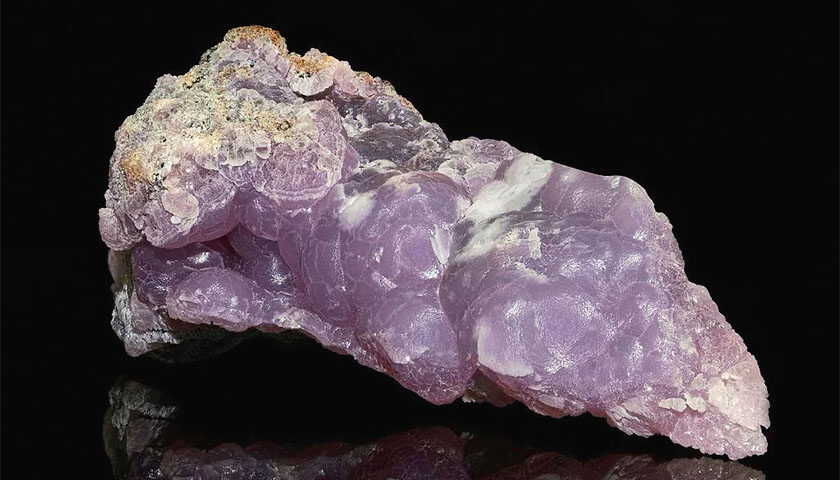
Smithsonite is not only a captivating mineral for collectors and enthusiasts but also a subject of interest for gemologists. Its unique characteristics make it a fascinating gemstone with various factors influencing its value and appeal.
Color: A Spectrum of Beauty
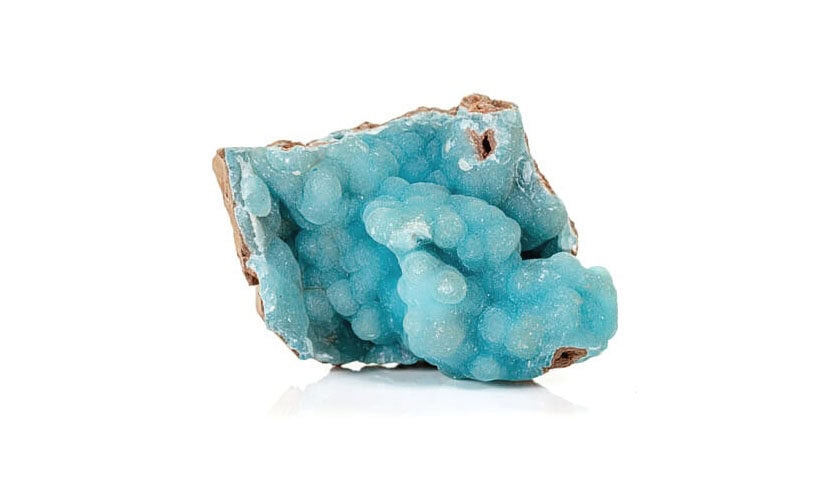
The color of smithsonite is perhaps its most striking feature, ranging from soft pastels to vibrant hues. Impurities within the mineral structure, such as copper, cobalt, cadmium, or iron, contribute to this wide color range. The most common colors are green and blue, but it can also be found in pink, yellow, and even colorless forms. The rarity and intensity of the color significantly affect the stone’s value, with the more vibrant and unusual shades being particularly prized.
Cut: Showcasing Nature’s Artistry
Due to its relative softness, smithsonite is a challenge for lapidaries to cut, requiring skilled hands to reveal its beauty without damage. While facetable material is rare, when properly cut, it exhibits high dispersion, making well-faceted specimens highly sought after as unique collector’s pieces. More commonly, smithsonite is found cut en cabochon, a style that highlights its color and luster and is more forgiving of the stone’s softness.
Clarity and Carat Weight: Size and Purity
In its colorless form, smithsonite might lack the brilliance or clarity to mimic diamonds, but it still offers a distinct and subtle beauty. Often, specimens contain inclusions of other minerals, which can either detract from or enhance their appeal, depending on the nature and visibility of these inclusions. Smithsonite typically forms in small to massive formations, and while large, well-formed crystals are rare, they command higher prices when they do appear on the market.
Treatments: Enhancing Natural Beauty
While smithsonite is generally not treated or enhanced, some specimens, particularly those with botryoidal formations, may be surface-oiled to improve their luster. This treatment is relatively minor and helps to showcase the stone’s natural beauty without significantly altering its appearance.
Mining and Formation of Smithsonite
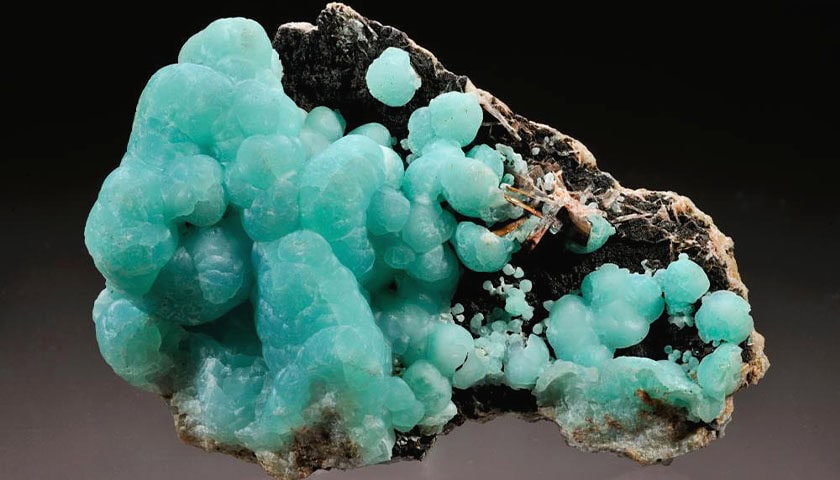
Understanding how smithsonite forms and is extracted can provide valuable context for appreciating this mineral’s beauty and rarity.
Geological Processes
Smithsonite forms through secondary processes, typically where zinc deposits are exposed to carbon dioxide and water, leading to the oxidation of the primary zinc ore, sphalerite. This process results in the formation of smithsonite, often found as fracture fillings and botryoidal or stalactitic coatings in limestone and other country rocks. The specific conditions under which smithsonite forms contribute to its varied appearance and rarity.
Mining Smithsonite
Mining for smithsonite involves locating zinc deposits, often through the identification of surface outcrops of the mineral. While large-scale mining for smithsonite specifically is uncommon due to the availability of more easily processed zinc ores, it is often collected as a byproduct of zinc mining. Smithsonite specimens are most commonly retrieved from small-scale mining operations and as secondary finds in zinc mines, making each piece a rare and valuable capture from the earth.
Conclusion
Smithsonite is more than just a mineral; it’s a natural marvel with a rich history and a wide array of uses and meanings. From its early days as a vital ore of zinc to its current status as a cherished collector’s gem, smithsonite has captivated humans with its beauty and versatility.
A Stone for Collectors and Healers
For gem collectors, smithsonite offers a rainbow of colors, unique formations, and the thrill of rarity. For those interested in the metaphysical, it promises emotional healing, spiritual growth, and physical well-being. Its gentle energy and diverse properties make it a beloved stone among many.
Continuing Fascination
As we continue to explore and understand the natural world, smithsonite remains a symbol of human curiosity and our deep connection to the earth. Its story is one of discovery, science, and beauty, intertwining our past with our present and future. Whether admired in a museum, worn as a piece of jewelry, or held as a comforting presence, smithsonite continues to be a source of wonder and inspiration.

